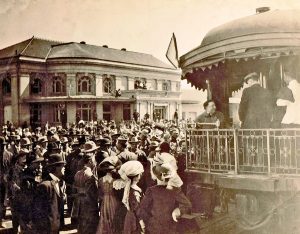
Grand Junction’s second train depot as seen soon after its opening in 1906. Photo courtesy of the Museums of Western Colorado
On June 27, 1943, a freight train traveling west toward Grand Junction, Colorado developed a hot box (an overheated axle) when passing through a rail tunnel in De Beque Canyon. The train stopped in Palisade, where workers repacked the axle. A hot box was always dangerous, but in this case it was especially so, because this particular train carried munitions headed toward the front in World War II. The problem presumably fixed, the train continued toward Grand Junction. It arrived at the Grand Junction depot sometime in the early morning, and the conductor and crew went to The Beanery, a restaurant adjacent to the depot.
Unbeknownst to the crew, the hotbox had heated the floor of the train car to a dangerous degree before the problem was fixed. While the men were in the restaurant, the floor caught fire, and that’s when the mayhem started. Munitions stored in the car ignited, setting them off and spreading the fire to other cars. Frank Chiaro, who worked in the Denver and Rio Grande (D&RG) roundhouse and lived near the depot, awoke with his wife to the sound of explosions in the middle of the night. In his interview with the Mesa County Oral History Project, Chiaro remembered it being about 2 a.m. Chiaro ran to the window, where he saw shells streaking overhead, accompanied by deafening booms. Terrified and thinking they were under attack, he and his wife ran out of their brick house and sheltered behind it. Chiaro’s sister, Mary (Chiaro) Colosimo, lived nearby and also recalled the terror of thinking that they were under attack by a foreign power.
For the rest of the night, bombs fell over Grand Junction’s downtown, rattling windows, screaming overhead, and exploding. Toward dawn, explosions came less and less often, then finally stopped.
Back at the depot, Grand Junction’s fire department worked all night to stop the fire. Fire chief Charles Downing lost his arm in the firefight, and others from the fire and train crews sustained injuries. Only the heroics of D&RG switch-man Victor Griffith saved the depot, town, and people from further damage. According to more than one Mesa County Oral History Project interviewee, Griffith volunteered to separate the burning part of the train from the rest. He braved fire and explosions to uncouple the cars. This act allowed the part of the munitions train that was not on fire to be pulled back to tracks along the Gunnison River (below the Orchard Mesa Cemetery). Griffith was later commended for his courage and promoted to train master.
US Army engineers from Colorado Springs were apparently called in to diffuse the bombs that had fallen all over the downtown area. According to Chiaro, the engineers built a “trap” to destroy the munitions. Local residents reported the location of undetonated ordnances to the authorities, and the engineers brought them in for demolition.
Listen to the above excerpt from Frank Chiaro’s interview to hear him talk about the train depot fire. To find out about other events in Mesa County and Western Colorado history, such as the Murder of Maggie Herrick by Henry Herrick or the Strawberry Days Bicycle Race between Grand Junction and Glenwood Springs, search the Associated Events tab on the Mesa County Oral History Project site. And check out Kathy Jordan’s informative article “Artillery exploded for four hours in 1943 rail car mishap” from the website historic7thstreet.org.

Shout out to Victor Griffith!
A real JunkTown Hero.
Victor Griffith was indeed a hero! Thank you for the comment, Joe.
The photograph (shown above) has little to do with the article subject as written.
This particular historical photo, I believe, was taken at the Grand Junction Train Depot in the Spring of 1908 during William Howard Taft’s speaking tour when campaigning for the U.S. presidency. If correct, the massive gentleman seen with the magnificent “handlebar” mustache and seated on the rear platform of the Pullman train-car is none other than the (then future) President Taft.
Hi Walter,
You are indeed correct. This photograph was taken during Taft’s visit. Thank you very much for your comment and for your interest in local history.
Noel